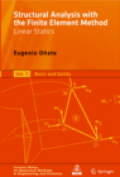
Structural analysis with the finite element method: linear statics v. 1 Beams, plates and shells
Oñate, E.
The two volumes of this book cover most of the theoretical and computational aspects of the linear static analysis of structures with the Finite Element Method (FEM).The content of the book is based on the lecture notes of a basic course on Structural Analysis with the FEM taught by the author at the TechnicalUniversity of Catalonia (UPC) in Barcelona, Spain for the last 30 years. Volume 2 presents a detailed description of the finite element formulation for analysis of slender and thick beams, thin and thick plates, folded plate structures, axisymmetric shells, general curved shells, prismatic structures and threedimensional beams. Each chapter describes the background theory for each structural model considered, details of the finite element formulation and guidelines for the application to structural engineering problems Emphasis is put on the treatment of structures with layered composite materials. A clear description of the theoretical and computational aspects of the FEM for structural analysis link to a web page with multimedia presentations of the chapter and manyexamples and exercises solved with computer programs INDICE: From the contents 3. Advanced 1D rod elements and requirements forthe numerical solution. 4. 2D solids. Linear triangular and rectangular elements. 5. 2D solids. Higher order elements. Shape functions and isoparametric formulation. 6. Axisymmetric solids. 7. Three dimensional solids. 8. Bending of slender beams. Euler-Bemouilli theory. 9. Thick/slender beams. Timoshenko theory. 10. Thin plates. Kirchhoffs theory. 11. Thick/thin plates. Reissner-Mindlin theory. 12. Analysis of shells using flat elements. 13. Axisymmetric shells.14. Analysis of arbitrary shape shells using degenerate solid elements. 15. Three-dimensional rods and shell stiffness. 16. Prismatic structures. Finite strip and finite prism methods. 17. Miscellaneous: inclined supports, displacements, constrains, nodal condensation error estimation and mesh adaptivity etc. 18. Pre and post-processing. Mesh generation and visualization of computer results. 19. Introduction to FEM programming.
- ISBN: 978-1-4020-8742-4
- Editorial: Springer
- Encuadernacion: Cartoné
- Páginas: 450
- Fecha Publicación: 01/01/2009
- Nº Volúmenes: 1
- Idioma: Inglés
